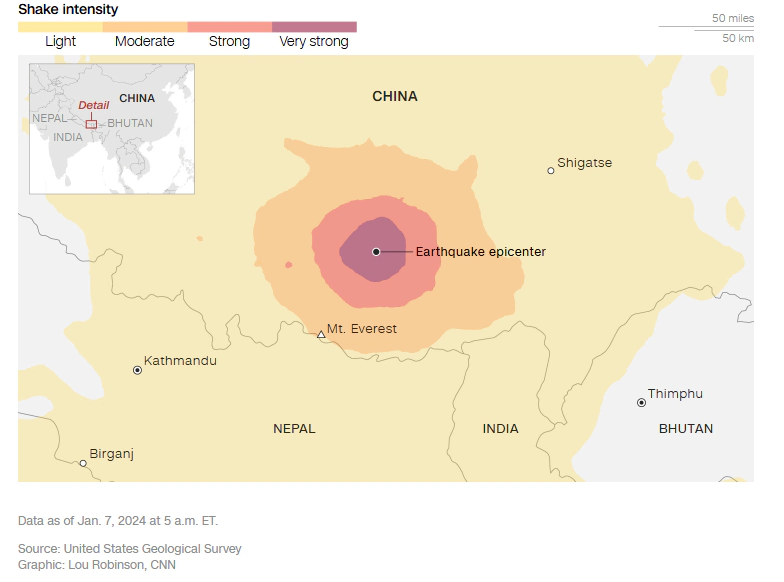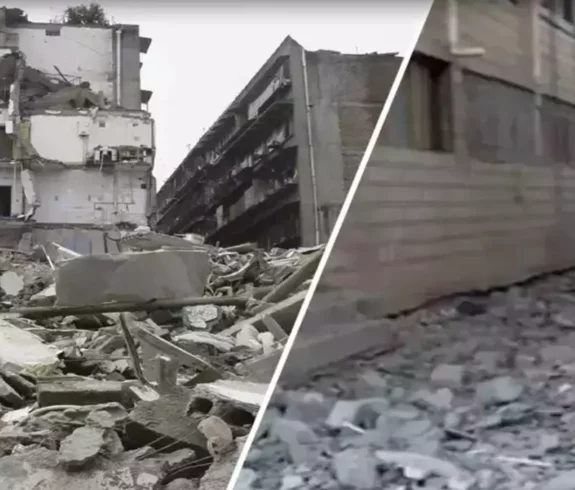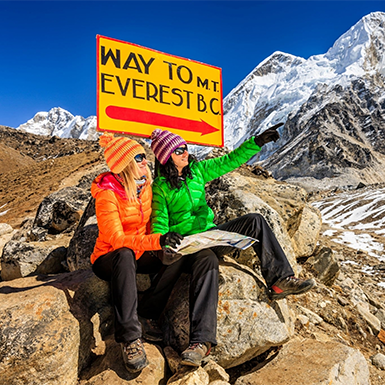Kathmandu, Nepal – A devastating Nepal-Tibet Border Earthquake struck a remote region of Tibet on Tuesday morning, resulting in a significant loss of life and causing tremors to reverberate across the Himalayan range, impacting neighbouring Nepal, Bhutan and parts of northern India. The earthquake, measuring 7.1 in magnitude according to the United States Geological Survey (USGS), occurred at 9:05 a.m. local time at a depth of 10 kilometres (6.2 miles). The initial quake was followed by numerous aftershocks, exacerbating the impact on the affected areas.

The seismic event’s force caused widespread damage, collapsing homes in remote Himalayan villages, shaking a nearby Tibetan holy city, and even being felt by those at a Mount Everest base camp. The epicentre was located in Tingri County on the Tibetan plateau, situated near the Nepal border, approximately 50 miles north of Mount Everest.
Reports from China Central Television (CCTV) indicate a grim toll, with at least 126 fatalities and 188 injuries attributed to the earthquake. The quake also inflicted substantial property damage, with over 3,600 homes reported as damaged.
The earthquake’s impact extended beyond Tibet, with tremors felt as far away as Kathmandu, the capital of Nepal. “It was very strong. People came running out of their houses. You could see the wires from poles shaken loose,” described Bishal Nath Upreti from the Nepal Centre for Disaster Management, a non-governmental organization based in Kathmandu, highlighting the quake’s reach.
By Tuesday evening, the China Earthquake Networks Center had recorded approximately 150 aftershocks, with 19 of them registering a magnitude of 3.0 or greater, underscoring the ongoing seismic activity in the region following the initial powerful quake.
A Focus on Safety and Swift Action:
Following the earthquake, the Nepalese government, in close collaboration with tourism authorities, immediately initiated comprehensive assessments of popular trekking routes. These evaluations focused on the structural integrity of trails, potential landslides, and accessibility of remote areas. The swift and thorough response confirmed that the well-known trekking routes, including:
- Everest Base Camp Trek: This iconic trek, leading to the foot of the world’s highest peak, remains entirely safe and accessible. All trails, bridges, and teahouses along the route have been inspected and confirmed to be structurally sound.
- Annapurna Circuit: The breathtaking Annapurna Circuit, renowned for its diverse landscapes and cultural encounters, also operates without any disruptions. The trails, villages, and infrastructure along the circuit are unaffected by the earthquake.
- Langtang Valley Trek: The scenic Langtang Valley, known for its stunning mountain views and Tamang culture, has also been declared safe for trekking. The trails and surrounding areas have been thoroughly checked, ensuring the safety of trekkers.
- Other Trails: Numerous other popular treks, including those in the Kanchenjunga region and lesser-known routes across Nepal, have also been confirmed safe and open.
Similarly, authorities in Tibet and Bhutan conducted immediate assessments, confirming that their respective trekking trails have experienced no impact from the earthquake. This ensures that the diverse trekking experiences offered in these regions, from high-altitude adventures in Tibet to cultural trails in Bhutan, remain available to travellers.
A Message of Resilience, Hope, and Continued Hospitality:
While the earthquake has brought hardship to certain areas of Tibet, the overall message from Nepal, Tibet, and Bhutan is one of resilience, hope, and unwavering hospitality. These nations have a long history of facing natural challenges and emerging stronger, demonstrating an extraordinary capacity for recovery. They remain committed to welcoming visitors and sharing the beauty of their landscapes and cultures.

Key Takeaways and Responsible Travel Practices for Travelers:
- Safety First, but Don’t Cancel Plans: While the trekking trails are confirmed safe, it is crucial for travellers to remain informed. Check for the latest travel advisories from official sources and follow the guidance provided by local authorities and trekking agencies.
- Respectful and Sensitive Travel: It is essential to travel with sensitivity and respect for the affected communities, particularly in Tibet. Be mindful of local customs and traditions, and avoid actions that could be perceived as insensitive during this challenging time.
- Support Local Communities and Businesses: Tourism plays a vital role in the economies of these Himalayan nations. By choosing to travel and support local businesses – including teahouses, guides, porters, and local restaurants – travellers directly contribute to the recovery and well-being of these communities. Consider purchasing locally made products and engaging with local guides to maximize the positive impact of your travels.
- Embrace the Natural Beauty and Cultural Richness: Nepal, Tibet, and Bhutan offer unparalleled natural beauty and rich cultural experiences. Continue to explore these incredible destinations, appreciate the stunning landscapes, engage with local cultures, and experience the warm hospitality that these regions are known for.
- Consider Volunteering or Donating: If you are able, consider contributing to reputable organizations that are providing aid and support to the affected areas in Tibet. Volunteering your time or making a donation can make a significant difference in the recovery efforts.
A Call to Action: Supporting Sustainable Tourism:
The tourism industry is a crucial lifeline for the Himalayan region. By choosing to travel responsibly, travellers can play a significant role in supporting the economic recovery and long-term sustainability of these incredible destinations. Responsible tourism practices ensure that the benefits of tourism are distributed fairly among local communities, minimizing negative environmental impacts and promoting cultural preservation.
Looking Ahead: Building Back Stronger:
The earthquake serves as a poignant reminder of the power of nature and the importance of preparedness and resilience. Nepal, Tibet, and Bhutan have a proven track record of overcoming adversity and rebuilding stronger. The spirit of these communities is truly inspiring, and their ability to bounce back from challenges is a testament to their strength and determination.
Conclusion: Nepal-Tibet Border Earthquake
Despite the devastating impact of the earthquake in parts of Tibet, the trekking trails in Nepal, Tibet, and Bhutan remain open and safe, offering incredible opportunities for travellers to experience the beauty and culture of the Himalayas. By choosing responsible and supportive travel, visitors can contribute to the recovery of these regions and ensure that these remarkable destinations continue to inspire and enchant travellers for generations to come. It is important to emphasize that while tragedy has struck one area, the broader region remains ready to welcome visitors and share its unique treasures.


